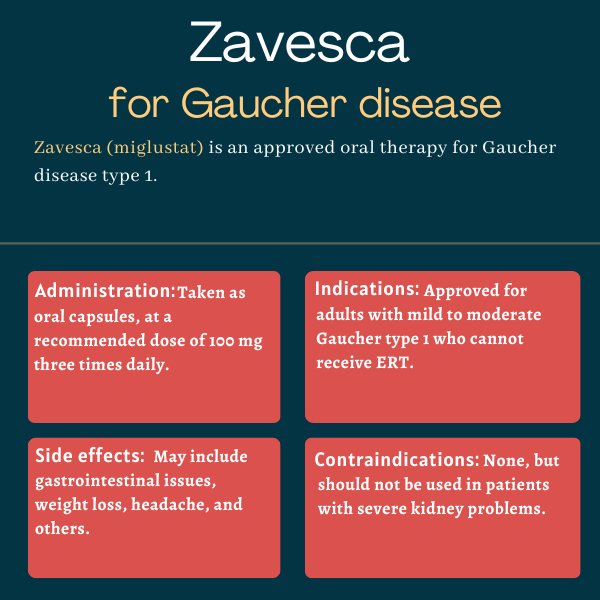
Zavesca (miglustat) for Gaucher disease
Last updated April 25, 2025, by Lindsey Shapiro, PhD

What is Zavesca for Gaucher disease?
Zavesca (miglustat) is an oral substrate reduction therapy that’s approved for adults with mild to moderate Gaucher disease type 1 who cannot receive enzyme replacement therapy (ERT).
Taken three times per day, Zavesca is designed to ease Gaucher symptoms and prevent complications by limiting the production of glucocerebroside (Gb1), the fatty molecule that harmfully accumulates in Gaucher disease due to a deficiency of the enzyme glucocerebrosidase (GCase). It works by inhibiting glucosylceramide synthase, an enzyme that’s needed to produce Gb1.
Zavesca offers an alternative Gaucher disease treatment for people who are unable to use ERT, which involves delivering a functional version of GCase via regular infusions into the bloodstream. The oral treatment can be beneficial, for instance, for patients who have experienced allergic reactions to ERT or whose veins are difficult to access.
The brand name therapy is currently marketed by Johnson & Johnson, and generic versions are also available.
Therapy snapshot
| Brand name: | Zavesca |
| Chemical name: | Miglustat |
| Usage: | Used to manage complications and ease symptoms of Gaucher type 1. |
| Administration: | Oral capsules |
Who can take Zavesca?
Zavesca is approved in the U.S. for adults with mild to moderate type 1 Gaucher disease for whom ERT is not a therapeutic option, for example, due to allergies, hypersensitivity, or poor venous access.
While there are no specific contraindications listed, Zavesca is generally not recommended for people with severe kidney problems.
The treatment is similarly approved for Gaucher in other regions, including the European Union and Canada. In some countries outside the U.S., Zavesca is approved for Niemann-Pick disease type C.
How is Zavesca administered in Gaucher disease?
Zavesca is administered orally in the form of hard gelatin capsules.
The recommended dose is 100 mg, taken three times a day at regular intervals. However, the healthcare provider may reduce the dosage to once or twice daily in people experiencing certain side effects or those with mild to moderate kidney impairment.
Clinical trials
Zavesca’s approval was supported by data from several studies where the medication was generally well tolerated and led to clinical improvement or stabilization in adults with Gaucher disease type 1. These included:
- Two open-label studies evaluated Zavesca as a standalone therapy in patients who were not suitable for ERT. In both studies, Zavesca led to significant reductions in liver and spleen volumes, and there was also a trend toward increased levels of hemoglobin (the protein in red blood cells that carries oxygen) and platelets. These clinical parameters continued to improve in patients who continued to receive Zavesca in the trials’ extension periods.
- An open-label Phase 2 switch study involved patients on ERT for at least two years who were randomly assigned to continue on ERT, switch to Zavesca, or receive Zavesca alongside ERT. Results showed people in all three groups had similar outcomes in terms of organ volume and blood-related parameters, and there was no additional benefit from combining Zavesca with ERT. In an extension where all received Zavesca for 1.5 years, most patients remained clinically stable or experienced additional improvements.
An open-label Phase 3 clinical trial (NCT00319046) in patients with stable disease on ERT who switched to Zavesca then confirmed the earlier findings, with most patients maintaining clinical stability in most disease parameters for two years.
Common side effects of Zavesca
Zavesa has been associated with a wide range of side effects in clinical trials, but most were considered mild or moderate in severity. Tremors and diarrhea were the side effects that most often required intervention.
Common side effects of Zavesca include:
- gastrointestinal problems, including diarrhea, stomach pain, gas, nausea, vomiting, indigestion, constipation, stomach bloating, and stomach pain unrelated to food
- weight loss and anorexia
- headache, including migraine
- tremors
- leg cramps
- dizziness
- weakness
- vision problems
- low platelet count, not associated with excess bleeding in clinical trials
- muscle cramps
- back pain
- dry mouth
- heaviness in the arms and legs
- memory loss
- unsteady walking
- abnormal sensations, such as burning, tingling, or numbness
- menstrual changes.
Patients should be monitored for tremors, diarrhea, and weight loss, which may warrant a dose reduction or treatment discontinuation. Dietary changes may help manage diarrhea.
A less common, but more serious side effect that can occur with Zavesca is peripheral neuropathy, characterized by symptoms of nerve damage such as pain, weakness, numbness, or tingling. Patients should be monitored for peripheral neuropathy and if it occurs, they should consider stopping treatment.
Gaucher Disease News is strictly a news and information website about the disease. It does not provide medical advice, diagnosis, or treatment. This content is not intended to be a substitute for professional medical advice, diagnosis, or treatment. Always seek the advice of your physician or other qualified health provider with any questions you may have regarding a medical condition. Never disregard professional medical advice or delay in seeking it because of something you have read on this website.
Recent Posts
- Bone complications affect most people with Gaucher disease, study finds
- Gaucher treatment doesn’t normalize key biomarker levels
- Constant medical vulnerability can be exhausting
- Understanding genetic factors seen key to personalized therapy
- Researchers uncover seven new genetic variants in Gaucher disease



